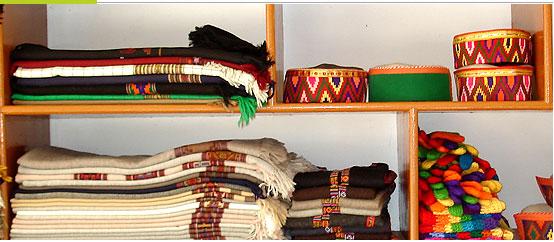
But setting up a supply chain is easier said than done. Some of the issues that have come up are inherent to this industry and its people. We have tried to highlight some of these issues and their reasons from the perspective of both the co-operative society and the weaver.
One of the foremost problems is the fact that the supply of authentic shawls is majorly only in the valley (mostly for tourists) and this market is still uneducated about the differences between a hand woven authentic Kullu shawl and a power loom shawl. But yet the demand exists amongst connoisseurs and discerning customers outside of the valley, not just in India but in various parts of the globe as well. Tapping this demand requires a steady supply of shawls going from the valley to various parts of the country and around the world. This however, is proving to be a challenge on multiple grounds. Primary among them is the fact that the big players in the valley produce only enough to feed their retail chains and small export markets (via government organised handloom exhibitions). But, the problem doesn’t entirely lie with the management of these organizations. They aren’t willing to expand because of the decreasing number of weavers in the valley who are willing to work full time. Also the incentive to recruit more weavers is low for these societies because of the unavailability of raw material and in house finishing facilities.
At the worker level, more and more weavers are leaving this profession and seeking employment in horticulture, tourism and recently, even hydropower stations. And as the standard of living increases people are reluctant to enter this profession. Major portion of the existing weavers are only part time. They divide their time between agriculture and weaving and weaving takes the back seat for most part of the year. This is extremely saddening, considering weaving in the valley was once a revered task. Now weaving, which has become a poor man’s occupation, pays on an average Rs 120 per day. And since the wages are paid piece wise, a weaver will have to put in a good 8 hrs of work before he gets as much.
This has led to a vicious circle today, leaving us unable to identify and address the root cause of the problem. Complicating matters further is the fact that the problems don’t end here.
The government, on its part has tried to revive the industry by introducing various subsidies and schemes for the co-operatives which should have helped reduce the deterioration in the number of weavers. But a lot of these societies are only on paper. They claim the subsidies, show losses on fictitious assets and purloin the money. This underlying corruption combined with the massive bureaucratic structures of functioning co-operatives has ensured that the money rarely filters down to the grass root level. Also, small scale industries / co-operatives that claim aid from The Department of Industries have to show a minimum of 3 years profits before they can do so. While this is expected to streamline the funds to the truly deserving co-operatives, it doesn’t do much to the struggling & relatively new societies that need help in their formative years.
Another major road block is the inherent lassitude amongst people in the area. It prevails in all levels; government officials to weavers. The weavers are complacent, are tuned to the seasonal nature of demand (May-July, November-January) and are hardly aware of the schemes that should actually benefit them.
Topping it all is the sheer lack of awareness amongst the consumer that has already been spoken about extensively. A local tourist with average purchasing power is only looking for a souvenir from the place and this need of his is satiated as long as the shawl is bought in Kullu, irrespective of where or how it’s made.
But despite these complexities, there is hope. There is a chance of revival of this industry because of the rapidly growing demand for socially conscious products; products that are known to make a difference to a community or a tradition, but it can be hard to reach these consumers directly. In order to do so, we have to address the above mentioned issues and ensure that the industry moves out of its existing downward spiral.
This is going to be our concerted effort and any help garnered in this regard would be greatly appreciated.
The above article has been written by Pooja Adiga and Ajay Simha. Both of them are students of S.P. Jain Institute of Management and Research, Mumbai. They are currently on a 6 week internship with My Himachal as part of their DOCC (Development of Corporate Citizenship) program. They are working with My Himachal to put into place a strong revival mechanism for the traditional Kullu Shawl weaving industry and one of their immediate plans includes the privatization of this industry.



